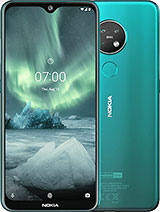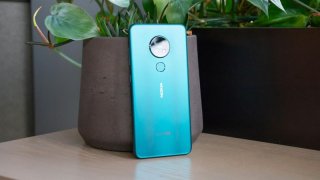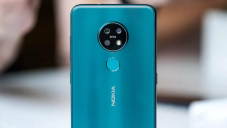Nokia 7.2
$224 | 19999
- 6.3" 1080x2280 pixels
- 48MP 2160p
- 4/6GB RAM Snapdragon 660
- 3500mAh Li-Po
Phone Finder
- Acer alcatel Allview Amazon Amoi Apple Archos Asus AT&T Benefon BenQ BenQ-Siemens Bird BlackBerry Blackview BLU Bosch BQ Casio Cat Celkon Chea Coolpad Cubot Dell Doogee Emporia Energizer Ericsson Eten Fairphone Fujitsu Siemens Garmin-Asus Gigabyte Gionee Google Haier HMD Honor HP HTC Huawei i-mate i-mobile Icemobile Infinix Innostream iNQ Intex itel Jolla Karbonn Kyocera Lava LeEco Lenovo LG Maxon Maxwest Meizu Micromax Microsoft Mitac Mitsubishi Modu Motorola MWg NEC Neonode NIU Nokia Nothing Nvidia O2 OnePlus Oppo Orange Oscal Oukitel Palm Panasonic Pantech Parla Philips Plum Posh Prestigio QMobile Qtek Razer Realme Sagem Samsung Sendo Sewon Sharp Siemens Sonim Sony Sony Ericsson Spice T-Mobile TCL Tecno Tel.Me. Telit Thuraya Toshiba Ulefone Umidigi Unnecto Vertu verykool vivo VK Mobile Vodafone Wiko WND XCute Xiaomi XOLO Yezz Yota YU ZTE
Nokia 7.2 Summary
After 2 years of "reviving" under the ownership of HMD Global, Nokia smartphone brand has continuously "bombarded" the mid-range segment with quality products for friendly prices. This year, Nokia 7.2 is the name that holds the strategic role of the company, but things are tending to change in a negative direction.
In 2019, there have been too many changes taking place in the mid-range segment. Samsung changed its strategy, focusing on bringing new features to the Galaxy A and M series; Realme has been growing fast since its separation from Oppo. Redmi / Xiaomi with strengths in hardware configuration and price is always an opponent that cannot be overlooked, ... and more.
Display
Nokia is a rare brand that equips HDR screens on its mid-range smartphones at the moment, and Nokia 7.2 still inherits that advantage. Combined with Nokia's PureDisplay technology, the color range and color accuracy of the screen are very good, and Nokia 7.2 also has the ability to upgrade SDR content to HDR thanks to the dedicated image processor.
In practical use, the 6.3-inch IPS LCD screen with Full HD + resolution of the Nokia 7.2 provides a good entertainment experience with wide color contrast range, vivid and realistic colors, especially the high level of brightness and clarity. The image processor automatically upgrades SDR content to HDR, so you don't need to do anything. YouTube or Netflix app does not display HDR content, but you can still see the difference. The brightness of the screen is also very good, according to the manufacturer, the Nokia 7.2 panel can reach a maximum of 500 nits, which is great for outdoor use.
Performance
The Nokia 7.2 is equipped with Snapdragon 660 chip, along with 4GB RAM and 64GB of internal memory. This is obviously not the most powerful mid-range chip today. This phone will certainly be more attractive in the segment if it owns another more powerful chip. However, the Snapdragon 660 can still handle most tasks, except for heavy gaming. Therefore, you will have to reduce the graphics settings a bit if you want to enjoy heavy-graphics games.
Despite having similar configuration to Nokia 7 Plus that we have previously reviewed, the Nokia 7.2 still has a 20% better performance in the AnTuTu test. This result is most likely due to a software difference when the Nokia 7 Plus at the time of the review was still running Android 8 Oreo while the Nokia 7.2 runs on Android 9. With the Snapdragon 660, PUBG Mobile is locked at 30fps while Dead Trigger 2 was not a challenge for Nokia 7.2 as the game ran smoothly at 60 fps.
As for software, the Nokia 7.2 comes pre-installed with Android 9 Pie. As part of the Android One program like many older Nokia devices, the software of Nokia 7.2 is very "pure" and does not contain any third-party apps, but only built-in Google applications (GMS) such as Maps or Youtube. In addition, Nokia 7.2 is also committed to updating software for up to 2 years.
Battery
The 3,500 mAh battery of Nokia 7.2 is hard to impress. 4,000 mAh has almost become a new standard in the smartphone industry. Even Apple's iPhone that is famous for its ability to optimize battery life has also come very close to this level (iPhone 11 Pro Max).
In our usual battery life tests, the Nokia 7.2 is significantly inferior compared to other products in the same segment. The actual usage time of the device is not impressive. I usually have to plug in the charger when I get home after a day of work.
Another disadvantage of Nokia 7.2 is that it does not support fast charging. Using the charger that came with the device, there is currently fast charging but the maximum capacity is only 10W. I tried changing to Oppo Quick Charge 3.0 and VOOC 3.0 and the device did show that it was fast charging, but the time for fully charging the battery is still the same as when I used the 10W adapter, which is 2 hours 25 minutes from 10%.
Camera
I had high expectations for the Nokia 7.2 camera. The camera specifications of the Nokia 7.2 are not bad at all, and they also have a good assistant, which is the famous Zeiss lens. However, when it comes to practical experience, I understand why big names like Google and Apple have poured more resources into developing software processing features on the camera.
Initially, the Nokia 7.2's camera app could not turn off the HDR feature automatically, nor did it have an option to quickly switch between regular and wide-angle cameras. The speed of taking and saving photos is also very long due to HDR processing.
In bright enough conditions, Nokia 7.2 gives good image quality as expected. Photos have good detail, a wide range of light, as well as vivid and accurate colors. When switching to the ultra-wide-angle camera, the image quality is significantly reduced, both in color, contrast, and detail. This is understandable, the specifications of the wide-angle camera obviously can not "match" with the main camera, but the difference in the Nokia 7.2 is more pronounced compared to other smartphones with a wide-angle camera.
Like every other smartphone, in low-light environments, the weakness of Nokia 7.2 also began to reveal. Photos still have quite a lot of noise and lack details. The hansdet also has a Night Mode to improve the image quality, which does make a slight difference.
Nokia says this mode can identify users using tri-pods to increase the exposure time, but really, how many people use tripods for phones, let alone midrange products like Nokia 7.2.
Nokia 7.2 Full Specifications
- Dollas $224 Buy in Flipkart >
- Rupee ₹19999 Buy in Flipkart >
- Technology GSM / HSPA / LTE
- 2G bands GSM 850 / 900 / 1800 / 1900 - SIM 1 & SIM 2
- 3G bands HSDPA 850 / 900 / 2100 - ROW
- 1, 3, 5, 8, 40, 41 - IN
- 4G bands 1, 3, 5, 7, 8, 20, 28, 38, 40, 41 - ROW
- Speed HSPA 42.2/5.76 Mbps, LTE-A (2CA) Cat6 300/50 Mbps or LTE Cat4 150/50 Mbps
- Announced 2019, September
- Status Available. Released 2019, September
- Dimensions 159.9 x 75.2 x 8.3 mm (6.30 x 2.96 x 0.33 in)
- Weight 180 g (6.35 oz)
- Build Glass front (Gorilla Glass 3), glass back (Gorilla Glass 3), plastic frame
- SIM Single SIM (Nano-SIM) or Dual SIM (Nano-SIM, dual stand-by)
- Type IPS LCD capacitive touchscreen, 16M colors
- Size 6.3 inches, 99.1 cm2 (~82.4% screen-to-body ratio)
- Resolution 1080 x 2280 pixels, 19:9 ratio (~400 ppi density)
- Protection Corning Gorilla Glass 3
- HDR10 Always-on display
- OS Android 9.0 (Pie), upgradable to Android 10.0; Android One
- Chipset Qualcomm SDM660 Snapdragon 660 (14 nm)
- CPU Octa-core (4x2.2 GHz Kryo 260 Gold & 4x1.8 GHz Kryo 260 Silver)
- GPU Adreno 512
- Card slot microSDXC (dedicated slot)
- Internal 64GB 4GB RAM, 64GB 6GB RAM, 128GB 6GB RAM
- eMMC 5.1
- Modules 48 MP, f/1.8, (wide), 1/2.0", 0.8µm, PDAF 8 MP, f/2.2, 13mm (ultrawide), 1/4.0", 1.12µm 5 MP, f/2.4, (depth)
- Features Zeiss optics, LED flash, panorama, HDR
- Video 2160p@30fps, 1080p@30fps (gyro-EIS)
- Modules 20 MP, f/2.0, (wide), 1/3", 0.9µm
- Features Zeiss optics, HDR
- Video 1080p@30fps
- Loudspeaker Yes
- 3.5mm jack Yes
- WLAN Wi-Fi 802.11 b/g/n/ac, dual-band, Wi-Fi Direct, hotspot
- Bluetooth 5.0, A2DP, EDR, LE, aptX
- GPS Yes, with A-GPS, GLONASS, GALILEO, BDS
- NFC Yes (excl. India)
- Radio FM radio
- USB 2.0, Type-C 1.0 reversible connector, USB On-The-Go
- Sensors Fingerprint (rear-mounted), accelerometer, gyro, proximity, compass
- Non-removable Li-Po 3500 mAh battery
- Charging Standard charging 10W
- Colors Cyan Green, Charcoal, Ice
- Models TA-1193, TA-1178, TA-1196, TA-1181
- SAR 1.15 W/kg (head) 0.90 W/kg (body)
- SAR EU 0.99 W/kg (head) 1.44 W/kg (body)
- Performance AnTuTu: 139495 (v7), 164484 (v8) GeekBench: 5440 (v4.4), 1398 (v5.1) GFXBench: 8.1fps (ES 3.1 onscreen)
- Display Contrast ratio: 1342:1 (nominal)
- Camera Photo
- Loudspeaker -29.6 LUFS (Average)
- Audio quality Noise -93.0dB / Crosstalk -93.4dB
- Battery life Endurance rating 69h
Nokia 7.2 News

Review - Jan 19, 2021
Nokia 7.2 Review: Decent All-Round Smartphone But There Are Better Picks

Mobile - Sep 24, 2019
Nokia 7.2 Is Now Available For Sale in India: Price, Specs, & Launch Offers

Mobile - Sep 19, 2019
Nokia 7.2 Silently Launched in India; Price Starts From Rs. 18,599

Mobile - Sep 09, 2019
Nokia 6.2 & Nokia 7.2 Android One Smartphones Announced With Triple Rear Cameras

Mobile - Sep 04, 2019











